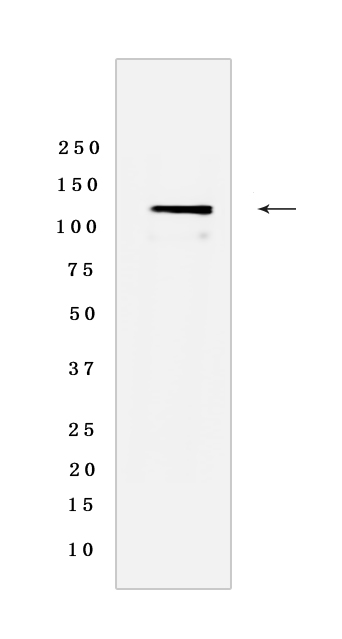NRF2 Rabbit mAb [5PMJ]Cat NO.: A15547
Western blot(SDS PAGE) analysis of extracts from NIH/3T3 cells.Using NRF2 Rabbit mAb [5PMJ] at dilution of 1:1000 incubated at 4℃ over night.
Product information
Protein names :Nfe2l2,Nrf2,NF2L2_MOUSE,Nuclear factor erythroid 2-related factor 2
UniProtID :Q60795
MASS(da) :66,901
MW(kDa) :110KD
Form :Liquid
Purification :Protein A purification
Host :Rabbit monoclonal IgG
Isotype :IgG
sensitivity :Endogenous
Reactivity :Mouse,Rat
- ApplicationDilution
- 免疫印迹(WB)1:1000-2000
- The optimal dilutions should be determined by the end user
Specificity :Antibody is produced by immunizing animals with a synthetic peptide of Mouse NRF2.
Storage :Antibody store in 10 mM PBS, 0.5mg/ml BSA, 50% glycerol. Shipped at 4°C. Store at-20°C or -80°C. Products are valid for one natural year of receipt.Avoid repeated freeze / thaw cycles.
WB Positive detected :NIH/3T3 cells
Function : Transcription factor that plays a key role in the response to oxidative stress: binds to antioxidant response (ARE) elements present in the promoter region of many cytoprotective genes, such as phase 2 detoxifying enzymes, and promotes their expression, thereby neutralizing reactive electrophiles (PubMed:9240432, PubMed:9887101, PubMed:12032331, PubMed:14517554, PubMed:31398338). In normal conditions, ubiquitinated and degraded in the cytoplasm by the BCR(KEAP1) complex (PubMed:15282312, PubMed:15367669, PubMed:15581590). In response to oxidative stress, electrophile metabolites inhibit activity of the BCR(KEAP1) complex, promoting nuclear accumulation of NFE2L2/NRF2, heterodimerization with one of the small Maf proteins and binding to ARE elements of cytoprotective target genes (PubMed:12032331). The NFE2L2/NRF2 pathway is also activated in response to selective autophagy: autophagy promotes interaction between KEAP1 and SQSTM1/p62 and subsequent inactivation of the BCR(KEAP1) complex, leading to NFE2L2/NRF2 nuclear accumulation and expression of cytoprotective genes (PubMed:20421418, PubMed:20173742). May also be involved in the transcriptional activation of genes of the beta-globin cluster by mediating enhancer activity of hypersensitive site 2 of the beta-globin locus control region (By similarity). Plays also an important role in the regulation of the innate immune response. It is a critical regulator of the innate immune response and survival during sepsis by maintaining redox homeostasis and restraint of the dysregulation of pro-inflammatory signaling pathways like MyD88-dependent and -independent and TNF-alpha signaling (PubMed:16585964). Suppresses macrophage inflammatory response by blocking pro-inflammatory cytokine transcription and the induction of IL6 (PubMed:27211851). Binds to the proximity of pro-inflammatory genes in macrophages and inhibits RNA Pol II recruitment. The inhibition is independent of the Nrf2-binding motif and reactive oxygen species level (PubMed:27211851). Represses antiviral cytosolic DNA sensing by suppressing the expression of the adapter protein STING1 and decreasing responsiveness to STING1 agonists while increasing susceptibility to infection with DNA viruses (By similarity)..
Tissue specificity :Widely expressed. Highest expression in liver, skeletal muscle, luminal cells of the stomach and intestine, lining of the bronchi and alveoli, and in renal tubules,followed by heart, spleen, testis and brain.
Subcellular locationi :Cytoplasm, cytosol. Nucleus.
IMPORTANT: For western blots, incubate membrane with diluted primary antibody in 1% w/v BSA, 1X TBST at 4°C overnight.


